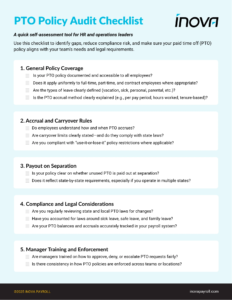A rigid or unclear paid time off (PTO) policy can quietly drain morale, drive turnover, and put your business at risk, especially in industries where burnout and staffing gaps are common. If your PTO policy feels rigid, confusing, or inconsistent, it may be costing you more than you think, whether it's increased turnover, compliance risk, or disengaged teams.
Whether you're running a hotel, managing a healthcare facility, operating a manufacturing plant, or directing a nonprofit, the way you offer and manage paid time off has a direct impact on your ability to retain talent.
This simple, yet effective guide outlines how to build a PTO policy that works for your organization, not against it. More importantly, it shows how strategic time-off design can improve morale, reduce turnover, and ensure compliance.
Why PTO Is a Retention Strategy, Not Just a Perk
Burnout, disengagement, and quiet quitting aren't just buzzwords, they're costing U.S. businesses an estimated $322 billion annually in lost productivity, turnover, and absenteeism. A major driver? Excessive workplace stress, especially from job insecurity, which 54% of U.S. workers say significantly affects their mental well-being.
Even when companies offer generous time off, inconsistent enforcement or confusing policies can cause resentment. In industries like hospitality and healthcare, employees often work long, emotionally demanding shifts. When taking time off feels like an inconvenience rather than a benefit, retention suffers.
A recent study published in the International Journal of Manpower found that voluntary turnover dropped by 35% among employees offered paid time off, even when job satisfaction didn't change.
You don't have to double PTO days to improve retention. You just need to remove friction.
The Core Elements of a Retention-Ready PTO Policy
Your PTO policy doesn't need to be complex. It needs to be easy to understand, consistently applied, and aligned with your business operations.
Here's what every effective PTO policy should address:
- Accrual structure: Hourly, per pay period, or seniority-based?
- Rollover rules: How much unused PTO can be carried into the next year?
- Blackout dates or limitations: Are there restricted periods during peak season?
- Eligibility: Do new hires receive immediate access, or is there a waiting period?
- Sick days vs. personal days: Are they separated or pooled together?
- Emergency leave: Is there flexibility for family or health emergencies?
Compliance Tip: If you operate in multiple states, your PTO policy must reflect local leave laws, including mandatory sick leave in California, New York, and Massachusetts. Labor law noncompliance penalties can range from $500 to $10,000 per violation, depending on jurisdiction and severity.
Inova helps simplify this complexity with tools that configure and automate PTO accruals based on each state's legal requirements, so your team stays compliant without the manual lift.

Know Where Your PTO Policy Stands
Gaps in your PTO policy can cost you compliance risks, frustrated employees, or missed improvements. Inova helps you spot issues and stay proactive.
Use this checklist to uncover opportunities for improvement and avoid costly PTO policy pitfalls.
Stay Ahead of the Turnover Curve
A weak PTO policy can quietly drain morale, drive turnover, and open your business to compliance risk. And in fast-moving industries, being reactive isn't an option. Don't get left behind when regulations shift or burnout spikes; get the right information before it costs you.
Subscribe to our newsletter for actionable insights, compliance updates, and time-saving strategies from experts who help service-based organizations stay ahead of compliance nightmares.
Customizing Your PTO Strategy by Industry
Each industry brings unique challenges when it comes to time-off planning. One-size-fits-all rarely delivers fairness or coverage.
Hospitality (Hotels)
- Identify blackout periods during peak travel seasons and communicate them well in advance.
- Cross-train key staff and implement a PTO request deadline system to ensure coverage during high-occupancy windows.
Healthcare
- Create tiered approval workflows that balance shift coverage while allowing equitable access to time off.
- Rotate blackout dates among departments to avoid overburdening the same teams repeatedly.
Manufacturing
- Use digital PTO tracking tools to detect patterns in unscheduled absences and intervene early.
- Pair structured accrual with real-time scheduling data to ensure consistent shift coverage and minimize disruptions.
Trades & Field Services
- Deploy mobile apps for time-off requests so crews can plan proactively without phone calls or paperwork.
- Use geofencing and time-tracking integrations to manage PTO and reduce time theft, which costs employers up to $11 billion annually.
Nonprofits
- Set clear PTO expectations during onboarding to support sustainable workloads for mission-driven teams.
- Build in mandatory recharge periods or use-it-or-lose-it windows to protect employees from burnout and overwork. One-size-fits-all rarely delivers fairness or coverage.
Common PTO Pitfalls That Undermine Retention
A well-intentioned policy can still fail if it's not supported by systems or culture.
Inconsistent Enforcement
When one manager allows time off freely and another doesn't, it creates confusion and resentment.
Standardize your approval process using your HR or payroll system to ensure consistent enforcement across departments.
Guilt-Based Culture
If employees fear using PTO will hurt their reputation, they'll avoid taking it—even when they need it most.
Normalize time off by having leaders model it, celebrate work-life balance, and clearly communicate the importance of using PTO.
Policy Confusion
Ambiguous or poorly communicated policies create stress and erode trust.
Use plain language and centralize the PTO policy in an easily accessible location. Review it during onboarding and in regular manager trainings.
Manual Tracking & Paper Forms
Outdated tracking methods cause delays, errors, and increase admin time.
Digitize PTO tracking with automated accruals and mobile access to reduce friction and improve accuracy.
You may think your employees don't need more time off. The truth is, they're just not asking anymore.
Rolling Out or Updating Your Policy the Right Way
A policy is only as effective as its rollout. Make sure your team understands how and when to use their PTO.
1. Get Leadership Buy-In
Start with the business case: turnover can cost your organization between 30% and 200% of an employee's annual salary, sometimes even up to 4x their salary for specialized roles.
2. Keep the Language Easy to Understand
Avoid legal jargon. If employees can't understand the policy, they can't follow it.
3. Use Digital Tools
Integrate PTO tracking and approvals into your HRIS or payroll system. Automation eliminates inconsistencies and saves time.
4. Communicate Often
Share updates across internal channels, include it in onboarding, and host Q&A sessions.
5. Encourage Feedback
Collect input and adjust as needed. Your PTO policy shouldn't be set-it-and-forget-it.
Put Your PTO Policy to Work
Your employees want to know they're supported when they step away from work. A well-built, easy-to-use PTO policy not only improves retention, it also builds trust.
Inova's all-in-one payroll and HR platform helps you design, manage, and automate time-off policies that align with your operational needs and compliance requirements. From mobile access to policy customization, we make it easy to retain your workforce and support your managers.
Learn more about Inova's time and labor management solutions >>
Take the Next Step Toward Retention-Focused PTO
You've read the strategy—now put it into action.
Download our free checklist to review your policy, identify red flags, and improve compliance and employee trust.




